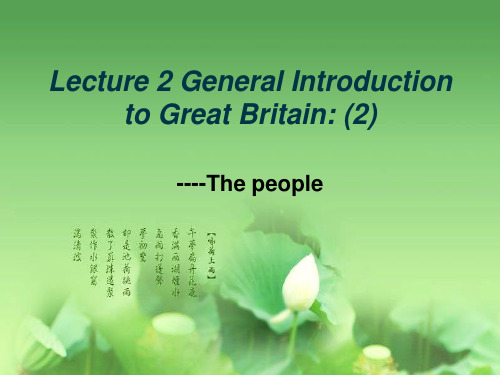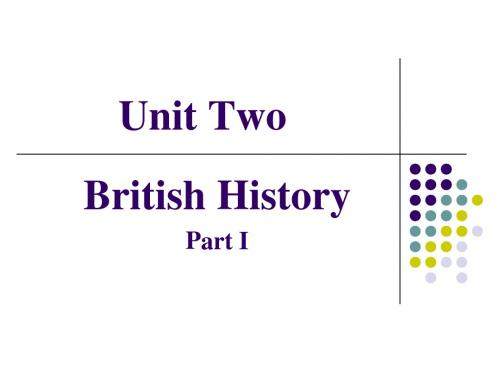英美概况讲义2-1
- 格式:rtf
- 大小:89.32 KB
- 文档页数:10


《英美概况教案》课件第一章:英国地理与文化1.1 英国地理位置与气候英国位于欧洲大陆西北部,由英格兰、苏格兰、威尔士和北爱尔兰组成。
英国气候温和,多雨,四季分明。
1.2 英国政治体系英国是一个君主立宪制国家,拥有国王或女王作为国家元首。
英国议会由两院组成:下议院和上议院,下议院议员由民众选举产生。
1.3 英国教育体系英国教育体系分为小学、中学和大学三个阶段。
英国大学以其悠久的历史和优秀的教学质量闻名于世。
1.4 英国文化特色英国文化源远流长,拥有丰富的文学、戏剧、音乐和艺术传统。
英国人注重礼仪和传统,喜欢下午茶和足球等体育活动。
第二章:美国地理与文化2.1 美国地理位置与气候美国位于北美洲,东临大西洋,西濒太平洋,北接加拿大,南界墨西哥。
美国气候多样,北部寒冷,南部炎热,西部海岸湿润,中西部干旱。
2.2 美国政治体系美国是一个联邦制国家,由50个州组成,拥有总统作为国家元首。
美国国会由参议院和众议院组成,参议员由州议会选举产生,众议员由民众选举产生。
2.3 美国教育体系美国教育体系分为小学、中学、高中和大学四个阶段。
美国大学以其多样性和创新性著称,拥有世界上最多的大学排名前100的名校。
2.4 美国文化特色美国文化多元且开放,拥有丰富的音乐、电影、科技和体育传统。
美国人注重个人主义和自由,喜欢户外活动、运动和社交聚会。
第三章:英国经济概况3.1 英国经济简述英国是发达国家之一,拥有强大的经济实力和先进的技术产业。
英国经济以服务业为主,特别是金融服务业在全球具有重要地位。
3.2 英国主要产业英国拥有发达的制造业,包括汽车、航空、制药等行业。
英国科技产业发展迅速,特别是在、生物科技等领域。
3.3 英国经济政策英国政府采取自由市场经济政策,鼓励企业创新和发展。
英国是欧盟成员国,与欧盟其他国家有着紧密的经济合作关系。
3.4 英国与他国的经济关系英国与美国、加拿大、澳大利亚等英语国家有着密切的经济合作关系。

专业课程《英美概况2》目录•课程介绍与教学目标•英国篇:政治、经济与社会制度•美国篇:政治、经济与社会制度•英美文化:传统、习俗与价值观•英美教育:体系、特点与发展趋势•英美科技:创新、应用与影响•总结与展望:深化对英美的理解与认识01课程介绍与教学目标《英美概况2》课程简介01本课程是英语专业的一门必修课程,旨在帮助学生深入了解英国和美国的历史、文化、政治、经济等方面的知识。
02通过本课程的学习,学生可以更好地理解和分析英美两国的社会现象和问题,提高跨文化交际能力。
03本课程采用多媒体教学和课堂讨论相结合的方式,鼓励学生积极参与和互动。
教学目标与要求知识目标掌握英美两国的基本概况,包括历史、文化、政治、经济等方面的知识。
能力目标能够运用所学知识分析和解决与英美两国相关的问题;提高跨文化交际能力。
情感目标培养学生对英美文化的兴趣和好奇心,增强跨文化意识和国际视野。
教材及参考书目教材《英美概况教程》(第二版),高等教育出版社。
参考书目《英国文化史》、《美国文化史》、《英美政治制度比较》等。
同时建议学生积极利用网络资源,如BBC、CNN等英文媒体,以及各类学术网站和数据库,获取最新的信息和资料。
02英国篇:政治、经济与社会制度英国政治制度及改革议会制度英国实行议会制,议会是最高立法机关,由上议院和下议院组成。
议会拥有立法权、财政权和监督权。
内阁制度英国内阁由首相和若干名大臣组成,是最高行政机关。
首相由下议院多数党领袖担任,负责组建内阁并领导政府。
选举制度英国实行普选制,选民通过投票选举产生议员和地方政府官员。
选举采取简单多数制,即获得最多选票的候选人或政党获胜。
英国经济发展现状与趋势经济现状英国是世界第五大经济体,拥有高度发达的工业、服务业和金融业。
伦敦是世界著名的金融中心之一。
经济发展趋势近年来,英国经济保持稳定增长,但面临着一些挑战,如人口老龄化、生产率增长缓慢等。
未来,英国经济将继续向数字化、绿色化和全球化方向发展。



I.Early Settlers (5000BC-55BC)早期的居民(公元前5000年-公元前55年)1.The first known settlers of Britain were the Iberians.⼈们所知的英国最早居民是伊⽐利来⼈。
2. At about 2000 BC the Beaker Folk arrived from the areas now know as Holland and Rhineland.约公元前2000年,从现在的荷兰和莱茵兰地区来了宽⼝陶器⼈。
3. The Celts began to arrive Britain about 700 BC.约公元前700年,克尔特⼈来到不列颠岛。
4. The Celts came to Britain in three main waves.克尔特⼈来到不列颠有三次⾼潮。
The first wave were the Gaels-came about 600 BC.第⼀次⾼潮是约公元前600年盖尔⼈的来临。
The second wave were the Brythons-came about 400 BC.第⼆次⾼潮是约公元前400年布⽴吞(不列颠)⼈的抵达。
The third wave were the Belgae-came about 150 BC.第三次是约公元前150年⽐利其⼈的到达。
II. Roman Britain (55BC-410AD)罗马⼈统治时期的英国(公元前55年-410年)1.British recorded history begins with the Roman invasion. In 55BC and 54BC, Julius Caesar, a Roman general, invaded Britain twice. In AD 43, the Emperor Claudius invaded Britain successfully. For nearly 400 years, Britain was under the Roman occupation, though it was never a total occupation.有记录的英国历史开始于罗马⼈的⼊侵。
英美概况1. 概述英美是指英国和美国,两个国家在历史、文化、经济等方面有着紧密的联系。
英国是位于欧洲的一个岛国,拥有悠久的历史和文化传统;美国是位于北美洲的一个大陆国家,是世界上最强大的经济体之一。
2. 历史背景2.1 英国历史英国的历史可以追溯到公元前1万年左右的旧石器时代。
公元43年,罗马帝国入侵不列颠岛,并建立了不列颠罗马省。
5世纪时,盎格鲁-撒克逊人开始从欧洲大陆迁徙至不列颠岛,建立了各个王国。
9世纪时,威塞克斯王朝统一了英格兰。
1066年,诺曼底公爵威廉一世在哈斯丁斯战役中击败了英格兰的哈罗德二世,并建立了诺曼底王朝。
14世纪后期,英法百年战争爆发,在这场战争中英格兰失去了大部分法国领土。
16世纪初,亨利八世发动宗教改革,英格兰成为新教国家。
17世纪中期,英国爆发了内战,最终奥利弗·克伦威尔夺取政权并建立了共和国。
1660年,英国恢复君主制。
18世纪后期至19世纪初期,工业革命在英国兴起,使其成为当时的工业中心。
19世纪时,英国成为世界上第一个工业化的国家,并在全球范围内建立了庞大的殖民帝国。
2.2 美国历史美洲大陆最早的居民是印第安人。
1492年,哥伦布发现了美洲大陆,并开启了欧洲人对美洲的探索和殖民活动。
17世纪初,英格兰开始向北美洲殖民,并建立了13个殖民地。
这些殖民地于1776年宣布独立,成立了美利坚合众国。
19世纪初至中期,美国经历了西部拓荒运动、南北战争等重要事件。
南北战争结束后,废除奴隶制度,美国逐渐工业化和现代化。
20世纪初至中期,美国崛起为世界上最强大的经济体之一。
两次世界大战后,美国成为超级大国,并在冷战时期与苏联展开了长达几十年的对抗。
3. 政治制度3.1 英国政治制度英国是一个君主立宪制国家,君主是英国的元首,但权力受到议会的限制。
议会分为上议院和下议院,下议院中的议员由选举产生。
英国政府由内阁和首相领导。
首相通常来自于执政党的领袖。
英国政治体系注重权力分立和民主原则。
Lecture 2:History of Britain2.1T h e O r i g i n s o f a N a t i o nThe Origins of a Nation(5000B C-1066)•I. Early Settlers•II. Roman Britain•III. The Anglo-Saxons•IV. The Viking and Danish Invasions•V. The Norman ConquestI. Early Settlers•1. The Iberians•2.The Beaker Folk•3. The CeltsI. Early Settlers (5000BC-55BC)Stonehenge •Stonehenge is surely Britain's greatest national icon, symbolizing mystery, power and endurance. Its original purpose is unclear to us, but some have speculated that it was a temple made for the worship of ancient earth deities. It has been called an astronomical observatory for marking significant events on the prehistoric calendar. Others claim that it was a sacred site for the burial of high-ranking citizens from the societies of long ago.•While we can't say with any degree of certainty what it was for, we can say that it wasn't constructed for any casual purpose. Only something very important to the ancients would have been worth the effort and investment that it took to construct Stonehenge.Stonehenge•The stones are greatAnd magic power they haveMen that are sickFare to that stoneAnd they wash that stoneAnd with that water bathe away their sicknessI. Early Settlers (5000BC-55BC)–(3) How about their civilization? (What did they bring with them?)•a)The art of pottery making•b)The ability to fashion (ornament with patterns) bronzetools•c)The custom of individual burial•d) The hill forts (堡垒) and small fortified towns (筑堡城镇).•The Maiden Castle is one of the finest examples.–(4) What was their religion?•Druidism(德鲁伊德教),the Druids—the wise men,astrologers, soothsayersII. Roman Britain(55BC—410AD)•1. Roman invasion of Britain•2. The Hadrian’s Wall•3. The Roman contribution•4. Limited Roman influenceII. Roman Britain (55BC—410AD)•the invasion was unsuccessful because of resistance, thesuccessful invasion did not take place until nearly a century–(3)In AD 43, Emperor Claudius invaded successfully–(4)For nearly 400 years Britain was under the Roman occupation, but it was never a total occupation.•First, as a result of resistance;•Secondly, Roman troops were often withdrawn from Britainto fight in other parts of the Roman Empire.–(2) The Romans realized that they could not conquer them. So they withdrew from the north, and built two great walls, theHadrian‘s Wall and the Antonine Wall, to resist the attacks. Hadrian‗s Wall 哈德良城墙–(3)The Romans made good use of Britain‘s natural resources.They built baths, temples, amphitheatres and beautiful villas.–(4) The Romans also brought the new religion, Christianity, to Britain.H a d r i a n‘s W a l lR o m a n A m p h i t h e a t r eR o m a n A q u e d u c tR o m a n R o a dRoman BathsThe Roman Baths complex is a site ofhistorical interest in the English city ofBath. The complex is a very well-preserved Roman site of public bathing.Roman BathsR o m a n I n f l u e n c e●Roman laws, taxes, engineering skills●Architecture●Roman social system●The Latin Language●System of writing and numbering●Introduced a system of organized government in towns ●Brought the new religion Christianity to BritainR o m a n C i v i l i z a t i o n●Roman towns: London, York, Bath--baths, temples, amphitheatres, aqueducts●Roman roads:--more than 5000 roads, a network of roads to connect large towns→"All roads lead to Rome."III. The Anglo-Saxons(446-871)•1. The Anglo-Saxons•2. The Heptarchy•3. Offa’s Dyke•4. Anglo-Saxons conversion to Christianity•5. Anglo-Saxons contributions•6. The Witan•7. The Privy CouncilIII. The Anglo-Saxons (446-871)盎格鲁-萨克逊人Anglo-Saxon invasion of Britain• 3. Offa’s Dyke欧发大堤–The Anglo-Saxon tribes were constantly at war with one another, each trying to get the upper hand.–(1) A long ancient earthwork–(2) Built in the 8th century by Offa, the King of Mercia, along hiswestern borders to keep out the Welsh–(3) As a boundary between England (to the east) and Wales (to thewest)The Heptarchy•Hep- meaning seven.•The heptarchy was the seven English kingdoms that existed between the sixth and ninth centuries consisting of Kent, Northumbria, Wessex, Mercia, Sussex, Essex and EastAnglia.Offa‘s Dyke--picturesOffa‘s Dyke--picturesKing Arthur•He united the British•His famous ―round table‖ knights– a more democratic system•He drove the Saxons back with his magical sword• A hero of the British•Against forefather of the English–(3) Augustine was remarkably successful in converting theking and the nobility, and he became the first Archbishop ofCanterbury.–(4) But the conversion of the common people was largelydue to the missionary activities of the monks in the north.Monasteries sprang up throughout the country and becameplaces of learning.•Pope Gregory I•Saint Augustine of Canterbury–(3) they devised the narrow-strip, three-field farming system(三田耕种制度), which continued until the agricultural revolution in the 18th century.–(4) they also established the manorial(庄园的) system(采邑制度), wherebythe lord of the manor collected taxes, and organized the local army.–(5) They created the Witan(council or meeting of the wisemen, 议会、贤人会议) to advise the king.•7. the Privy Council– (1) An advisory body to the Crown: a body that advises theCrown on matters of government.– (2) the predecessor of the Cabinet. It was the most important part of the government until the development of the Cabinet after1688.– (3) Its duties are now formal: it is the body through which theQueen makes certain orders, putting into effect decisions made by ministers.– (4) number of members: it has about 400 members, including allCabinet ministers, the Speaker of the House of Commons, the Archbishops of Canterbury and York, and senior Britishand Commonwealth statesmen.IV. The Viking and Danish Invasions•1. the Vikings•2. “Alfred the Great”Viking Invasions 787-1066•Danish seamen, painted mid-twelfth century.•A reconstructed Viking Age long house•Miniatures of two different types of long ships, on display at the Viking Ship Museum in Roskilde, Denmark.• a Viking battle• A giant Viking welcomes visitors to the town of Dannevirke in New Zealand, founded by 19th Century Scandinavian settlers.Viking InvasionIV. The Viking and Danish Invasions北欧海盗和丹麦人入侵•2. King Alfred–(1) Alfred was the king of Wessex.–(2) He defeated the Danes who attacked England and reached andagreement with them.–(3) The Danes gained control of the north and east of England, while Alfred ruled the rest.–(4) He also converted some leading Danes into baptized Christians.–The reign of Alfred was known for more than military success. He wasa codifier of law, a promoter of education and a supporter of the arts.After his death, he was buried in his capital city of Winchester, and is the only English monarch in history to carry the title, "the Great."–All this makes him worthy of his title ―Alfred the Great‖.Alfred the Great•871 A.D. takes throne and resists further encroachment •Truce of 886- divides England-Danes—East and NorthSaxons- SouthContributions of Alfred the Great •Preserved old British traditions•Encouraged learning and education•Translated Bede’s History from Latin to Anglo-Saxon –vernacular•Kept records of English HistoryAnglo-Saxon ChroniclesV. The Norman Conquest (1066)•1. King Edward, “the Confessor”•2. William the Conqueror•3. Consequences of the Norman Conquest•4. a mixture of nationalities of different originsV. The Norman Conquest (1066)诺曼征服•Edward is received in England, and is crowned.Westminster AbbeyPlace of worship & House of Kings•An architectural masterpiece of the 13th to 16th centuries, WestminsterAbbey also presents a unique pageant(历史演变)of British history – the shrine of St Edward the Confessor, the tombs of kings and queens, and countless memorials to the famous and the great.•It has been the setting for every Coronation since 1066 and for numerous other royal occasions.•Today it is still a church dedicated to regular worship and to the celebration of great events in the life of the nation. Neither a cathedral nor a parish church, Westminster Abbey is a ―Royal Peculiar‖ under the jurisdiction of a Dean and Chapter, subject only to the Sovereign.West Front of Westminster AbbeyV. The Norman Conquest (1066)–(3) The Battle of Hastings哈斯廷斯战役• A. In 1066, King Edward died with no heir, the Witan choseHarold as king.• B. William, Duke of Normandy, invaded England.• C. On October 14, the two armies met near Hastings. After aday‘s battle, Haroldwas killed and his army completely defeated.• D. William entered London shortly before Christmas, and onChristmas Day hewas crowned King of England in Westminster Abbey by the Archbishop of York.• E. This battle was very important on the way of the RomanConquest.N o r m a n C o n q u e s t–(3) The feudal system was completely established inEngland.–(4) Relations with the Continent were opened, andcivilization and commerce were extended.–(5) Norman-French culture, language, manners, andarchitecture were introduced.–(6) The Church was brought into closer connection with Roman, and the church courts were separated from the civil courts(世俗法庭).–(4) After that was the invasion of the Vikings and Danes.–(5) Finally, in 1066, William of Normandy invadedEngland and began the age of the Norman Conquest that resulted in great French influence.–Therefore, many different peoples of different origins are living in Britain. That‘s the reason why we say English nation is a mixture of nationalities of different origins.A Brief review●Early Settlers (the Iberians-the Beaker Folk-the Celts)●Roman invasion (brought the new religion—Christianity)●The Anglo-Saxons (Jutes, Saxons, Angles)●the real beginning of English nationality●The Viking and Danish invasion (King Alfred the Great)●The Norman Conquest (1066)●(feudal system completely established in England)Research Questions•Why to say ―British history has been a history of invasion‖? Illustrate this point with examples. How did each of the invasions influence English culture?。